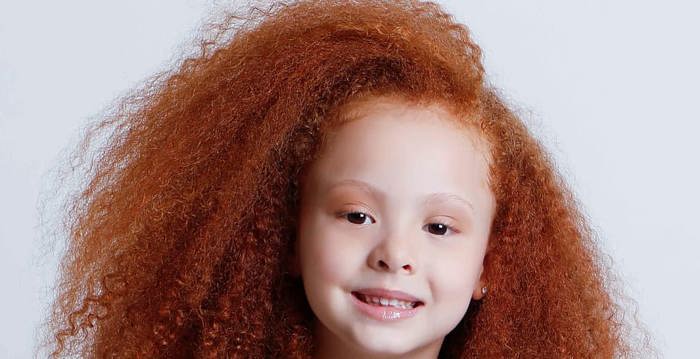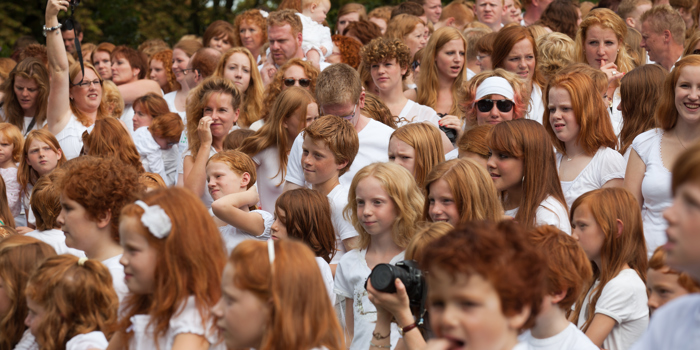
I have been wondering about this for a while… will red hair eventually go extinct?
March 6, 2014

- Related Topics:
- Red hair,
- Hair color,
- Population genetics,
- Carrier,
- Human evolution
A high school student from Nevada asks:
"I have been wondering about this for a while since I’ve seen it pop up on various websites and forums...will red hair eventually go extinct? I honestly don’t believe it will because it is recessive from what I know, and recessive genes don’t up and disappear."
You are exactly right. Unless we start burning redheads at the stake, they are here to stay.
But that doesn’t mean there isn’t some truth to what you’ve seen on the internet. While redheads won’t completely disappear, their numbers are set to go way down. Red hair is destined to become even rarer than it is today.
By doing a back of the napkin calculation, the number of redheads probably won’t ever sink below around 0.09% of the population. If we assume 7 billion people in the world, that means around 6.3 million redheads.
This is quite a drop from the 70 million or so that are alive today but it is hardly zero. And odds are that there will always be more than the 6.3 million I calculated.
Keep in mind too that this isn’t necessarily all bad news for red hair. Even as it becomes less common, red hair will become more widespread. In other words, a wider variety of people will be redheads even as the total number goes down.

Harder and Harder to Find
There will be fewer redheads in the future because people have started having kids with partners from other parts of the world. This makes it harder for two people who have a red hair gene to find each other and have kids. And in most cases this needs to happen for a couple to have a red haired child.
In places like Scotland or Ireland, 10% or more of the population has red hair. If they stick to themselves, the number of redheads will stay more or less constant in places like this. The odds are pretty good that someone with a red hair gene can find another person with a red hair gene to have kids with red hair.
Now imagine taking the population of Ireland and evenly spreading them throughout China, where red hair is incredibly rare. We take the 4.6 million Irish and add them to the 1.35 billion people in China. This makes it really unlikely that two people with a red hair gene will find each other and have kids. It will happen sometimes but it will become much rarer compared to if they had all stayed in Ireland.

A less extreme version of this is already happening. As travel becomes easier, people have a wider variety of potential mates to choose from.
But blue eyes won’t go away completely: the eye color gene versions that lead to blue eyes will still be hanging out in the human gene pool. It will just keep getting harder for people with these genes to find each other and have kids.
Billions of Copies in the Gene Pool
As I said, based on a world population of 7 billion, the lowest number of redheads in the world will probably be around 6.3 million. I figured this out using something called the Hardy Weinberg equation. All we need to use this equation is to figure out how many copies of the red hair gene version there are floating around in the human gene pool.
To figure out this number, we need to know both how many redheads and how many carriers there are. Carriers are people who have a single copy of the red gene version. They do not have red hair but their kids can.
Figuring out the number of redheads should be relatively straightforward — just look around and count! Unfortunately no one has really done this yet but current estimates are that something like 1% of the world has red hair.
Figuring out the carriers is a little trickier. We could sequence everyone’s DNA in the world and count them up that way but for now that is impractical. Using a variety of methods, scientists have come up with a 4% number for carriers.
From these numbers we need to figure out how many copies of the red hair gene there are in the world. As you may recall, we have two copies of most of our genes. The main gene involved in red hair, MC1R, is no exception. Most of us have two copies of this gene too.
The MC1R gene comes in two versions, red and not-red. Redheads usually have two copies of the red version while carriers have just one.

If we assume there are 7 billion people in the world, that means we have 70 million redheads, 280 million carriers and 6.65 billion people lacking the red version of the MC1R gene. This translates to 420 million copies of the red hair version (140 million from redheads, 280 million from carriers) and 13.58 billion copies of the not-red version (280 million from carriers and 13.3 billion from everyone else.
6.3 Million Redheads
We are now ready to calculate a lower limit for redheads. Like I said we’ll use the Hardy-Weinberg equation to figure this out.
This equation has two parts. The first part is that all the genes together have to equal 100% of the genes. Here is this part of the equation:
p + q = 1
In this equation, p is the not-red version and q is the red version. Also, the math is easier if we use decimals instead of percentages. So 50% becomes 0.5 and so on.
So we have a total of 14 billion copies of the MC1R gene (two for every person on Earth). Of these, 13.58 billion or 97% are the not-red version and 420 million or 3% are the red version.
The second part of the equation is to figure out what these numbers would settle to if there were no barriers to having kids. In other words, an Irishman is just as likely to have kids with a Chinese woman as he is with an Irish woman. Here is that equation:
p2 + 2pq + q2 = 1
In this equation, people who don’t have any red copies are p2, carriers are 2pq and redheads are q2. First we punch in our numbers to make sure these percentages work:
(.97)2 + 2(.97)(.03) + (.03)2 = 1
So the number of redheads left is (.03)2 or 0.09% of the population. This translates to 6.3 million out of a total of 7 billion.
As I said, this is more of a lower limit than a hard number. A big reason there will always be more is that the Hardy Weinberg assumes no barriers to mating. Any person in the world is as likely to have kids with any other person. Even in our global society this is not yet true (and probably never will be).
And of course the numbers could go way up or down for other reasons too. Maybe red hair is seen as wildly sexy and these people end up having more kids. Or the opposite could happen too.
But whatever happens, redheads will not be going extinct. They will almost certainly decrease in numbers but there will always be a few around. And luckily for redheads, their numbers will probably never get all the way down to 6 or 7 million.
Read More:
- Live Science: Are you Carrying the Redhead Gene?
- HowStuffWorks: Are redheads going extinct?

Author: Dr. Barry Starr
Barry served as The Tech Geneticist from 2002-2018. He founded Ask-a-Geneticist, answered thousands of questions submitted by people from all around the world, and oversaw and edited all articles published during his tenure. AAG is part of the Stanford at The Tech program, which brings Stanford scientists to The Tech to answer questions for this site, as well as to run science activities with visitors at The Tech Interactive in downtown San Jose.
 Skip Navigation
Skip Navigation
